In an era dominated by short-form video, it’s easy to believe the blog is dead. But Kieran and Yasmin Beckles, the creators behind Life with Klee Kai, prove otherwise.
While many other creators chase virality, they’ve built a thriving business where 90 percent of their revenue comes from affiliate content—and most of it is written.
By pairing a clean, search-optimized website with a playful, personality-driven social presence, they’ve turned a pet account into a sustainable income engine. Their approach offers a refreshing reminder that you don’t have to be everywhere all the time to succeed. You just have to show up with value, consistency, and a strategy that fits you.
We sat down with Kieran to talk about their effective blog affiliate strategy and why this format still matters in today’s creator economy.
- The history of Life with Klee Kai
- Why they monetize with affiliate marketing
- The Life With Klee Kai Content ecosystem
- Life with Klee Kai’s 5-stage journey to a winning affiliate strategy
- 5 steps to thrive in the ever-evolving creator economy
- Build a business that fits your strengths, not just trends
The backstory: How two sassy pups built a family business
Life with Klee Kai didn’t begin as a business. It started with the Beckles’ two dogs, Skye and Copper, and an Instagram account created to share their photos with friends, family, and other Alaskan Klee Kai owners.
But Skye and Copper weren’t just photogenic. They had star power.
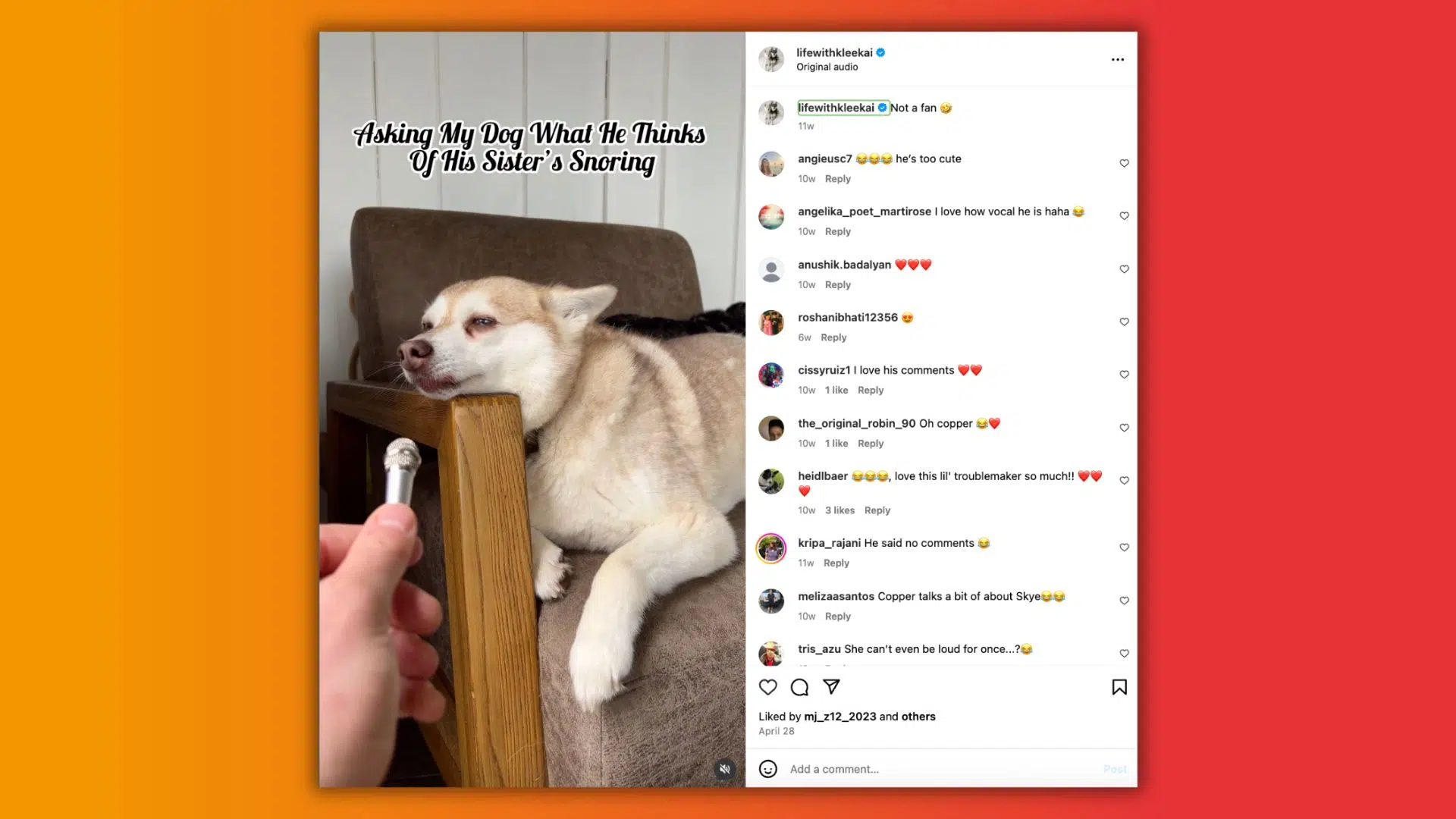
In this Instagram post, Copper’s bold attitude is on full display as Kieran “interviews” the pup about Skye’s snoring.
Their contrasting personalities complemented each other perfectly. Skye was the reserved, thoughtful observer, while Copper was the boisterous, talkative entertainer.
As short-form video platforms like TikTok and YouTube Shorts took off, their daily antics started reaching a much wider audience.
The Beckles joined these platforms early and saw their channels grow quickly. What began as a fun side project soon started bringing in brand deals and revenue. By the time their daughter was born, it was clear that content creation had grown beyond being a hobby—it was a full-time opportunity.
Today, Life with Klee Kai is a thriving family business that allows the couple to spend more time at home, lean into their creative strengths, and build a brand around their beloved dogs.
Kieran describes how the beloved account followers love today came to be.
Why they traded brand deals for a 90% affiliate model
When the Beckles moved from the UK back to California, one thing became clear: brand deals weren’t as easy to come by. The competition was tougher, the offers less frequent, and relying on one-off campaigns started to feel unsustainable.
Instead of chasing the next deal, Kieran leaned on his journalism background by creating SEO-friendly reviews and comparison content on the Life with Klee Kai website and YouTube channel.
The shift in their monetization strategy paid off. Not only did affiliate revenue prove more stable, but it also gave them full creative control.
Today, affiliate partnerships make up around 90 percent of the business’ income, offering the consistency and freedom many creators are looking for.
| Brand deals vs. affiliate deals | ||
| Feature | Brand deals (sponsorships) | Affiliate model (performance-based) |
| Income type | Flat fee, one-off payment | Recurring, performance-based commissions |
| Consistency | Unpredictable | Higher potential for consistent monthly income |
| Creative Control | Often requires molding content around brand campaigns | Full creative freedom to promote genuinely liked products |
| Competition | High, often competing with many other creators | Less direct competition, focused on search intent |
| Payout Timeline | Can involve waiting 60+ days for payment | Steady, predictable monthly payouts |
| Authenticity Risk | Higher risk of content feeling “clunky” or inauthentic | Promotes products genuinely used and believed in |
| Scalability | Dependent on securing new deals constantly | Grows with evergreen content, passive over time |
| Pressure | Constant pressure to chase next deal | Significantly reduces financial pressure |
Diving into the Life with Klee Kai online ecosystem
As Skye and Copper’s personalities began to shine through their content, the account evolved into a daily dose of joy for a global audience.
Today, fans aren’t just there because they happen to own a Klee Kai (though some do). They show up because the dogs feel relatable.
It’s this emotional connection, not just breed-specific content, that keeps people coming back. And it’s also what makes Life with Klee Kai feel more like a community than just another pet account. It’s also how they built the trust that turned them into an affiliate marketing powerhouse.
Before we discuss how they monetize, let’s explore how their content ecosystem works and why it’s so effective for increasing affiliate conversions.

Kieran and Yasmin Beckles have built a booming content business alongside their two Klee Kais, Copper (left) and Skye (right).
The website: The affiliate content hub
While social media drives visibility, the Life with Klee Kai website is the real workhorse behind their affiliate revenue. Today, the site receives an average of 40,000 unique visitors per month.
Kieran launched the site in 2022 with a clear purpose: to create helpful, SEO-driven content that answers real questions current and aspiring pet owners are asking. Think honest product reviews, side-by-side comparisons, and firsthand insights based on what Skye and Copper actually use.
Key content types on the site include:
- Product reviews: Detailed analyses of specific pet items.
- Brand comparisons: Side-by-side evaluations to help users choose between different pet products.
- Breed information: Articles specific to dog breeds, particularly Alaskan Klee Kai, covering aspects like traits, maintenance, and suitability.
- General pet ownership advice: Broader blog posts offering tips, insights, or discussions relevant to owning and caring for pets (e.g., training, health, lifestyle with pets).
They select topics based on audience pain points identified through Google searches, Reddit discussions, and community questions, ensuring they provide valuable information that truly matters to their audience.
Instead of cluttering the page with distractions, they place focus on value-driven content that converts. “We don’t run Google ads on the site. If I land on a site with pop-ups and ads everywhere, I click out. I didn’t want our visitors to experience that,” he says.
And their value-first approach works. The site is their top affiliate driver, offering consistent income without relying on platform algorithms or brand partnerships.
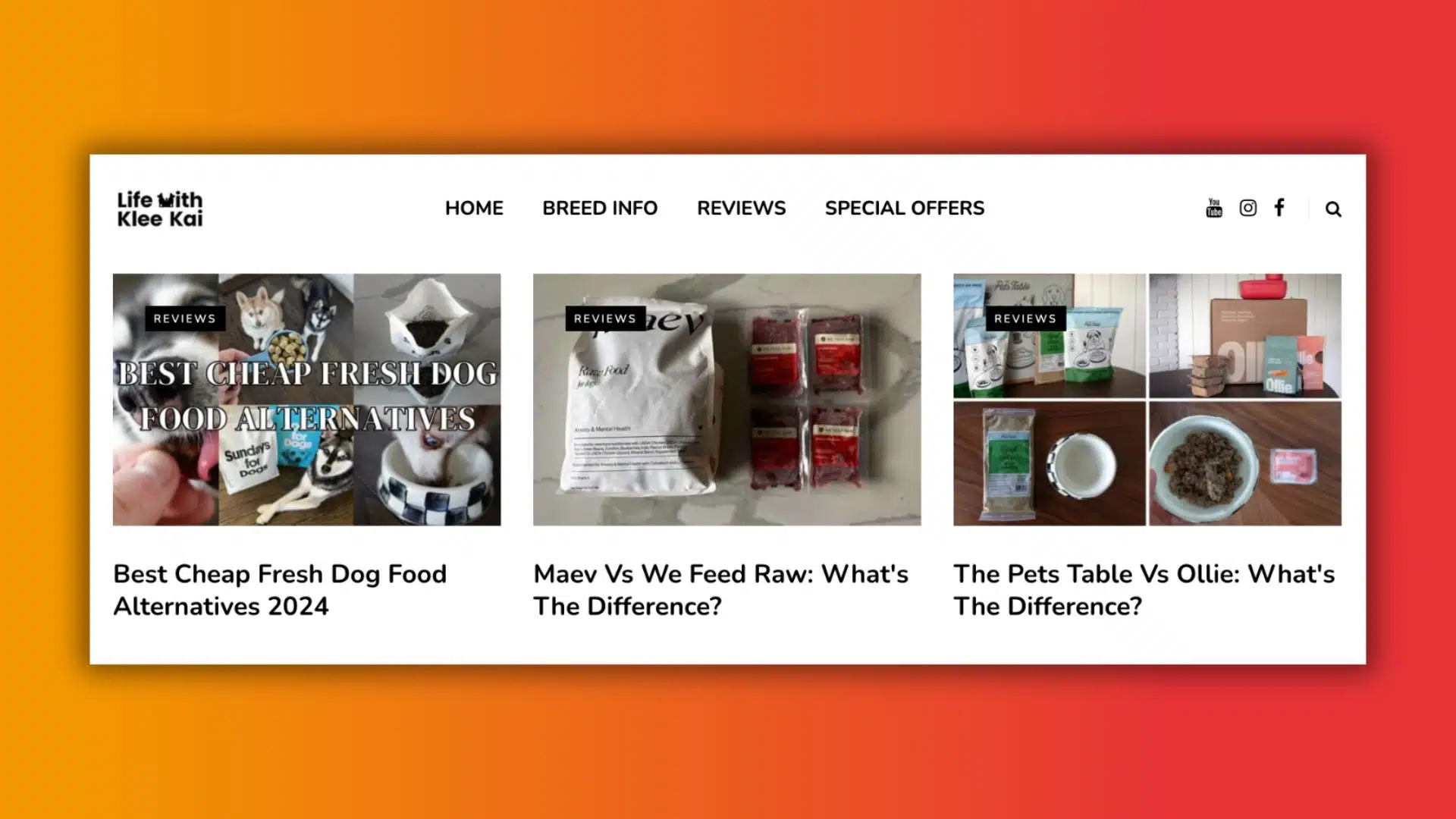
The Life with Klee Kai website covers a wide variety of content and review types to benefit its audience while working in affiliate links.
Social media: Powering audience growth
Life with Klee Kai has a strong presence on TikTok (4.3m followers), Instagram (306k), and YouTube (1.03m), with short-form video being a core pillar of their content strategy.
Kieran credits their early platform adoption for a lot of their growth. “We joined TikTok early, and that really helped establish our audience there. Then when Instagram moved to Reels and YouTube launched Shorts, we already had a bank of content ready to go,” he says.
This proactive embrace of new platforms laid the groundwork for their unique content ecosystem, where both short and long-form video play distinct yet complementary roles in engaging their audience and driving affiliate success on their website.

Short-form video (TikToks, Reels, Shorts)
Short form content is where their audience first connected with the dogs’ personalities. The content is light, funny, and low-lift—a perfect fit for short-form platforms.
Some common content beats include:
- Playful challenges and reactions: These videos feature the dogs reacting humorously to various sounds, games, or specific prompts set up by their owners.
- Everyday dog life and humor: This category includes relatable scenarios of common dog behaviors, funny quirks, and amusing moments from their daily lives, often showcasing Copper’s dramatic outbursts, Skye’s quiet sass, and sibling-style banter.
- Affection and bonding: These videos highlight the heartwarming and loving relationships between the Alaskan Klee Kai dogs and their human owners, often showcasing cuddles or tender moments.

Their short-form content is a masterclass in canine charisma, packed with everything from heartwarming snippets to side-splitting reaction videos that brilliantly showcase their dogs’ distinct personalities.
Long-form video (YouTube)
While their YouTube channel has over a million subscribers, not all formats perform equally well.
Their content falls into a few key categories:
- Breed information and care: This category includes videos that provide facts, essential information, and tips for owning and preparing for an Alaskan Klee Kai.
- Dog product reviews: This category features videos that review various dog products, offering recommendations and honest opinions.
- Dog behavior and interaction: This category focuses on more entertaining videos that explore the behavior of mini huskies, including their reactions to certain words and human interactions.
Generally, the search-optimized content—such as pet product reviews and comparison—perform the best. These videos support their affiliate revenue generation by reaching video viewers that are poised to buy.
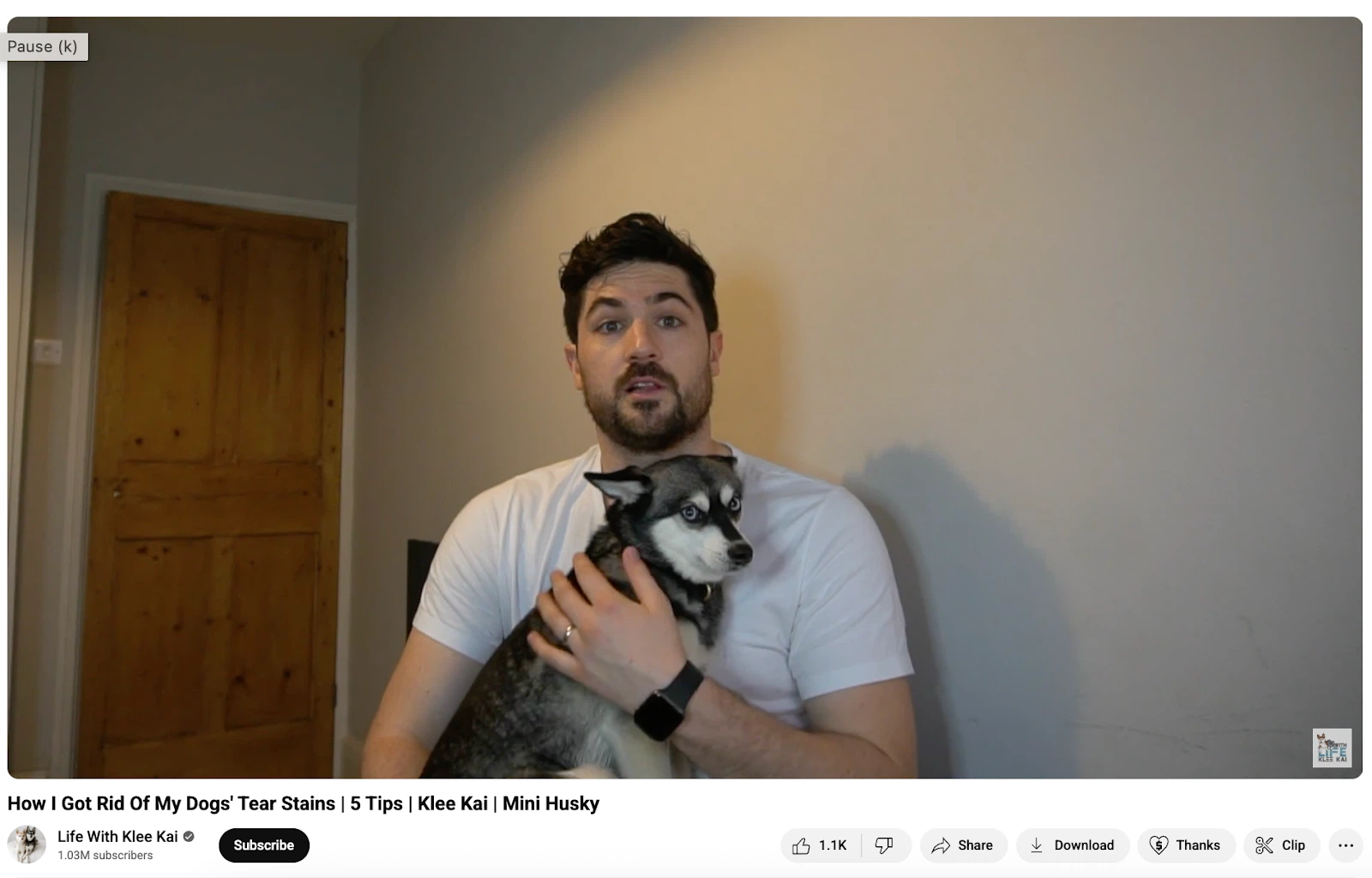
Kieran brilliantly cracks the code on a frequent canine conundrum: dog tear stains. This video delivers a clear set of solutions, showing owners how to banish them for good.
Life with Klee Kai’s 5-stage journey to a winning affiliate strategy
Before affiliate income made up 90 percent of their business, the Beckles focused on building trust with their audience. Their strategy didn’t come together overnight. It evolved through trial, reflection, and staying true to what felt right.
Here’s how Life with Klee Kai turned an authentic creator presence into a sustainable affiliate model.
Stage 1: Grounding all promotional content in authentic experiences
Before affiliate revenue became a core focus, Kieran made one key decision: every product they promoted had to be rooted in real experience.
That meant setting a firm rule early on that he would only promote products that Skye and Copper had actually tried and liked. Skye, being a famously picky eater, became a natural filter.
Instead of positioning himself as a detached expert, Kieran chose to speak as a fellow dog owner. His reviews reflect that tone—honest, practical, and based on lived experience.
“I make it really clear I’m just a dog owner. Not a pet nutritionist. Not a vet. Just someone who’s tried a lot of products over the years,” he explains.
This foundation of authenticity became their biggest competitive edge and part of their personal brand. Because in affiliate marketing, trust is everything.
Stage 2: Finding the right home for high-intent content
Once Kieran committed to creating in-depth, honest reviews, he needed the right place to publish them.
“Our short-form video fueled audience growth, but it wasn’t the best format for helping someone make a purchasing decision,” he says.
Instead of chasing fleeting social media trends and hoping they’d convert, Kieran embraced a format many creators have moved away from: a traditional blog.

The Life with Klee Kai website became the hub for SEO-driven, evergreen content designed to answer the exact questions pet owners were searching for.
This shift to traditional blog content let him use his SEO knowledge to meet readers with high purchase intent searching for specific solutions on Google.
While SEO is important, he continually focuses on “making sure that ultimately it’s the reader’s experience that is number one” and ensuring the content remains genuinely helpful and trustworthy.
By being transparent and audience-focused, he turns website visitors into customers with a smooth, no-fuss path to conversion.
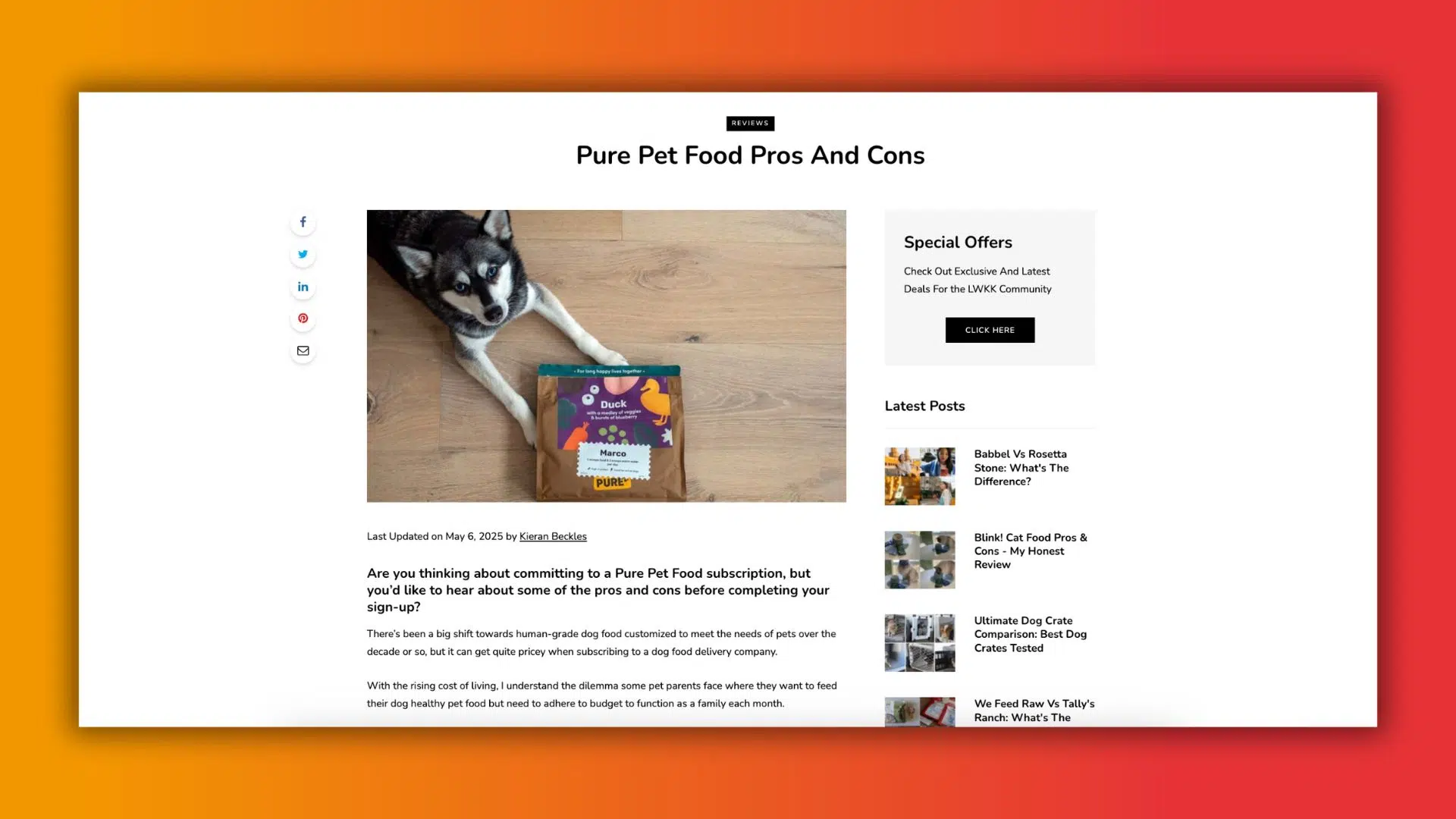
Life with Klee Kai’s blog content targets specific, high-intent keywords that help readers who are actively researching products. This approach answers their questions during the crucial consideration phase of their buyer’s journey, effectively leading them toward a purchase via an affiliate link.
Stage 3: Building a smart, multi-channel content strategy
Kieran didn’t try to force affiliate links into every social post. Instead, he flipped the typical approach by positioning social media as the content amplifier, not the driver.
“I haven’t really found a natural way to integrate affiliate links into our daily content. What works better is just answering questions and pointing people to the articles,” he says.
The upside to this approach? When people ask what Skye eats or which crate Copper prefers, Kieran doesn’t have to sell. He simply shares a link to the relevant article.
His large TikTok, Instagram, and YouTube audiences serve two purposes:
- Build community through personality-driven content
- Establish authority so followers trust his recommendations
He’s also repurposed written reviews into long-form YouTube videos, capturing high-intent users who prefer to watch instead of read.
By using social media to create demand and the website to convert interest, Kieran has built a multi-channel strategy that works across platforms and content preferences. This sustainable approach allows them to maintain consistency without succumbing to the pressure of daily uploads.
Stage 4: Working with best-fit brands for affiliate partnerships
Once the content strategy was working, Kieran turned his focus to the business side, choosing affiliate partners that aligned with his values.
He quickly learned to be selective, knowing that a brand’s reputation and user experience were as crucial as the product itself. “I would obviously make sure that it’s a reputable brand. We’d definitely check out their website, try and order their food, and get acquainted with the customer experience,” he explains.
He also likes to ensure the brand’s website is clear and easy to navigate before partnering with them.
The biggest red flag in a partnership? Brands that try to control or edit his reviews.
“We’ve had brands ask to change what I wrote or compare it to their competitors. That’s an immediate turn-off,” he shares, “But today, I’m confident in setting boundaries around this with partners.”
Instead, he prioritizes partners who respect his creative freedom and communicate proactively, sharing updates on new products or letting him know what’s working.
Kieran describes his process for selecting and working with brand partners.
Stage 5: Creating financial security with a diverse range of brand partners
After establishing strong, authentic partnerships, Kieran learned that true security comes from a diverse portfolio of brand partners. Relying too heavily on a single brand, no matter how successful, carries inherent risks.
In one instance, Kieran saw a Google update significantly impact one of their top affiliate partners, causing their revenue from that brand to drop by at least half. This firsthand experience underscored the vulnerability of a concentrated portfolio.
To mitigate such risks, he now champions building a small, varied portfolio of trusted brands. “I would say obviously try and maybe aim for five brands that you really like and start with those,” he suggests.
This approach not only provides a buffer against external changes but also offers creators greater freedom to promote products they genuinely believe in, without the pressure to chase the highest payout.

Offers like this Butternut Box discount show Life with Klee Kai’s commitment to strategic diversification, building a resilient affiliate portfolio by partnering with trusted brands that genuinely provide value to their audience.
5 steps to thrive in the ever-evolving creator economy
The creator economy is constantly evolving. You have to juggle everything from keeping up with algorithm updates to handling the pressure of staying relevant on every new platform.
But Kieran’s approach offers a grounded alternative. Walk through these five steps to see how creators can build lasting success by focusing on strategy, sustainability, and what makes their content truly stand out.
Step 1: Audit your content strengths
Before you build anything, understand what already works for you. Kieran’s success didn’t come from forcing himself into trending video formats that didn’t fit his niche or personality.
Instead, he identified that his strength lay in providing detailed, honest information through written content. This allowed him to create evergreen articles that served a high-intent audience.
To apply this:
- Analyze your current content. Which pieces or formats consistently perform well in terms of engagement, time spent, or direct questions from your audience?
- Identify your unique expertise. What topics do you genuinely know inside and out? What problems can you uniquely solve for your audience?
- Consider your comfort zone. If being constantly on camera feels draining, explore alternative formats like written, audio, or visuals where your personality can still shine without constant performance pressure.
Step 2: Create your authority hub
Once you know your content strengths, build a central hub where that value can live and grow.
For Kieran, this was the Life with Klee Kai website. While Google updates “killed” his older, SEO-heavy websites, his current blog thrives because it’s backed by genuine content and a strong social presence.
To apply this:
- Build a primary content platform. This could be a personal website, blog, or YouTube channel designed for long-form, evergreen content.
- Focus on high-intent topics. Create content that answers specific questions that your audience is actively searching for.
- Prioritize the user experience. Make your hub clean, easy to navigate, and free of distractions.
- Actively link social to your content hub. Signal to search engines that your long-form content is backed by real-world experience and a genuine audience by linking your authoritative social profiles to your blog.

The Life With Klee Kai social posts are both entertaining and purposeful, seamlessly tying into their affiliate content. They highlight products like the crates they use and showcase their dogs’ picky eating habits, building trust while driving interest.
Step 3: Develop your multi-channel growth system
Don’t just be on every platform—make every platform work together. Kieran’s growth was a result of strategically using different channels to build out their content ecosystem.
He and his wife were early to TikTok, Instagram Reels, and YouTube Shorts, which allowed them to build massive visibility.
This momentum then fueled the credibility of their website, setting them up for affiliate success.
To apply this:
- Be an early adopter. Experimenting with emerging platforms and new features early can provide a significant algorithmic boost and direct access to fresh audiences before the space becomes saturated.
- Define each channel’s role. Use short-form video for quick engagement and audience growth, and direct that audience to your authority hub—such as a blog or long-form YouTube channel—for in-depth, high-intent content.
- Repurpose content intelligently. Turn written reviews into YouTube videos or short social clips that tease longer articles, allowing you to reach audiences with different preferences.
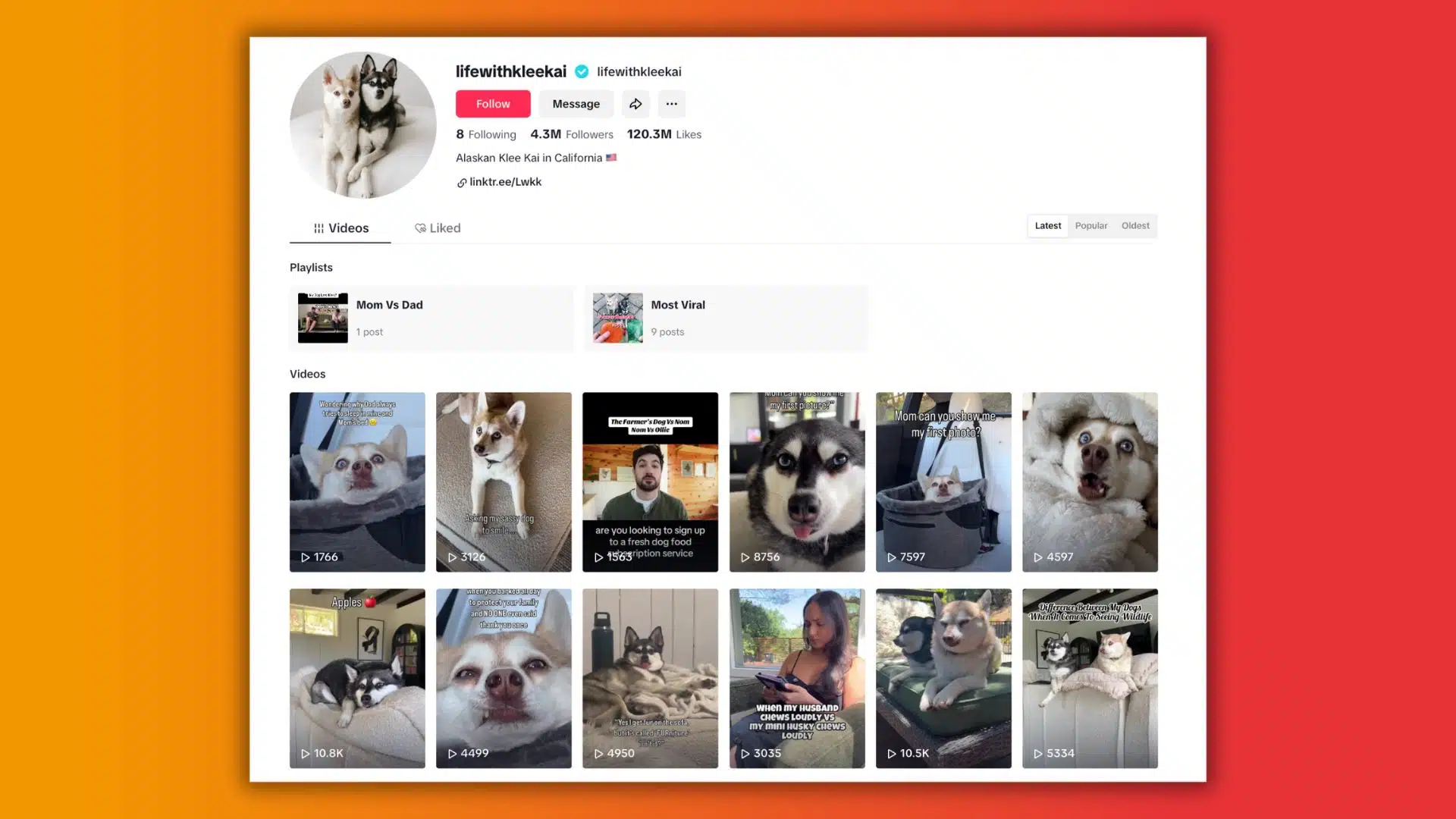
Life with Klee Kai’s TikTok illustrates how their engaging, personality-driven short-form videos became an explosive engine for audience growth by leveraging early platform adoption.
Step 4: Find your differentiator
Kieran’s approach proves that authenticity sticks far longer than fleeting trends. “If you’re doing everything everybody else is doing, it’s much harder to stand out,” he says.
He’s watched other pet creators explode by committing to quirky or niche ideas that weren’t trending at the time but eventually took off. The key was not just being different, but owning that difference with consistency.
To apply this:
- Identify your unique angle. What makes your content or perspective different? It could be a specific niche, a unique storytelling style, an underrepresented audience you serve, or a surprising twist on a common topic.
- Commit to your voice. Your unique approach will build stronger audience loyalty than chasing every new trend.
- Don’t fear being niche or unconventional. Sometimes, the most authentic and enduring success comes from outside the mainstream.
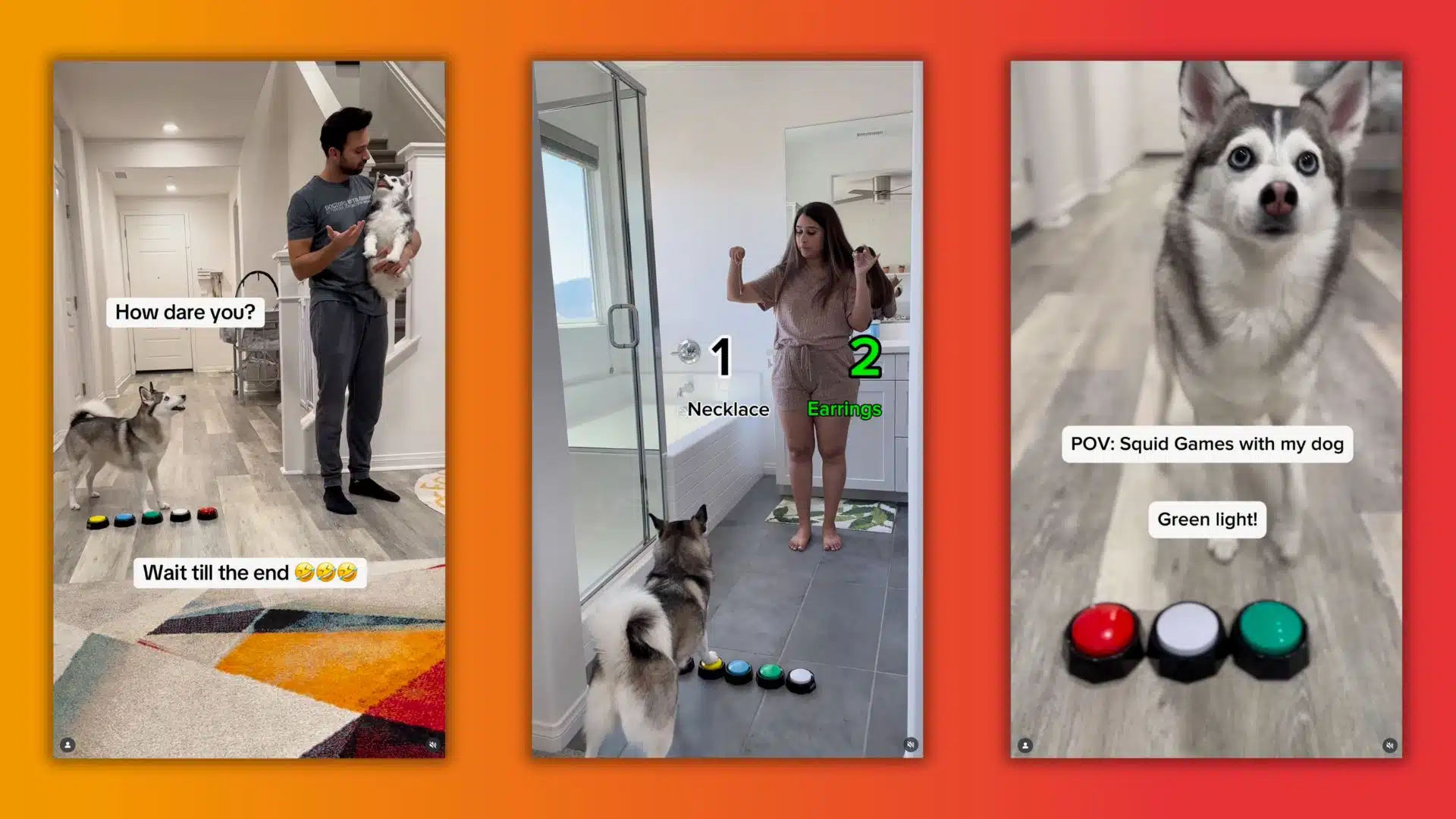
Kieran referenced Sapphie the Pomsky to show how finding your unique angle makes all the difference. While plenty of dogs were already “talking” by pressing buttons, it was Saffy’s bold, sassy personality that set her apart—and made her content go viral.
Step 5: Scale and optimize for consistency
True success is about building sustainable systems that prevent burnout and ensure consistent income.
Kieran now posts two to three times a week instead of daily. This change, based on his available time rather than platform pressure, reflects his focus on sustainability.
To truly embrace this approach, think beyond just what you can do, and focus on what you can consistently do without sacrificing your well-being or the quality your audience expects. This means strategically managing your output and actively seeking ways to stabilize your finances.
To apply this:
- Prioritize sustainability over intensity. Find a rhythm that allows for quality and consistency over the long term.
- Diversify your revenue streams. Explore various monetization avenues—such as affiliate, ads, courses, sponsorships, and more—to build financial resilience.
- Diversify your partners. Aim for a small, trusted portfolio of brands to buffer against market changes.
- Continuously optimize. Regularly review your performance data, learn from what works, and refine your strategies so you’re always improving for long-term success.
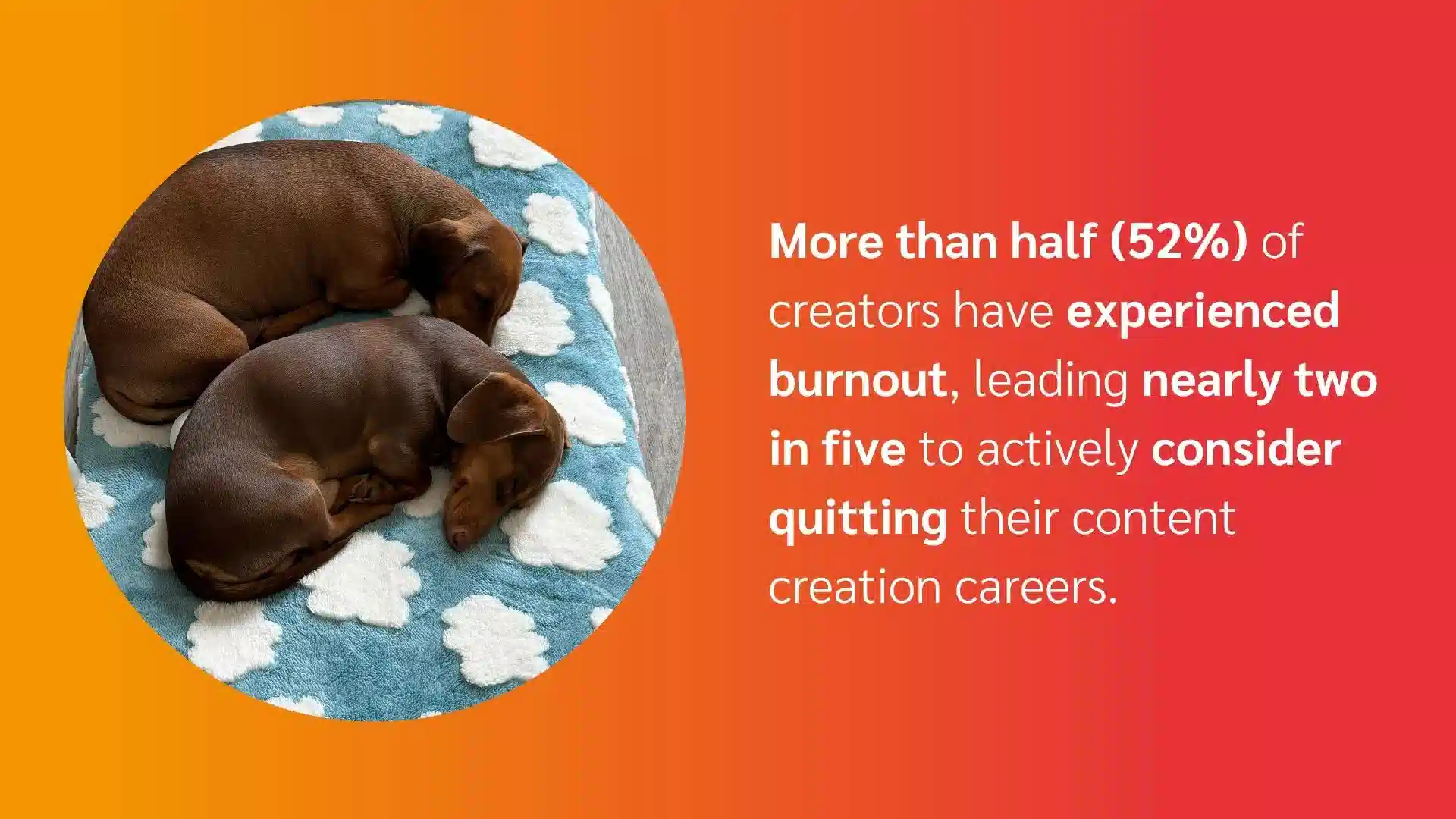
Source: Billion Dollar Boy
Build a business that fits your strengths, not just trends
The Beckles don’t follow the typical creator playbook. They don’t chase virality or rely on constant brand deals. Instead, they built a thriving affiliate business by putting authentic, long-form written content at the center, and using social media to amplify it.
Their journey proves that in a space dominated by fast-moving trends and algorithm shifts, a deliberate, values-driven approach can lead to both profitability and creative freedom.
If you feel burnt out by the constant push to do more and post faster, their strategy offers a different path grounded in trust, patience, and consistency.
You don’t need to copy what’s trending. Double down on what you do best, whether that’s video, audio, writing, or something entirely your own. When you lead with value and build with intention, you’ll create something that lasts.
Thank you to Kieran Beckles for contributing his expert insights. Follow Life with Klee Kai on YouTube, Instagram, and TikTok. You can also check out their website to see all of the knowledge they have to offer.
For more tips on affiliate and content creation, check out these resources:
- 9 advanced affiliate marketing strategies for sustainable revenue growth [blog]
- Creator’s guide: 6 best places to share affiliate links for maximum earnings [blog]
- Content creator affiliate strategy: How Charlie Chang hit 80% affiliate income with searchable video content [blog]
FAQS
To maximize affiliate earnings on a blog, focus on creating high-quality, in-depth content that genuinely helps your audience solve problems or make informed decisions. This often includes comprehensive product reviews, detailed comparison guides, and “how-to” articles that naturally integrate affiliate links as solutions. You must stay up-to-date on the latest challenges your audience faces in your specific niche.
Optimizing content for search engines helps ensure that your articles reach users who are actively looking to buy, rather than just browse. Regularly updating your content with fresh information and new product insights can also significantly boost long-term performance.
Strategies that target high-intent audiences typically yield the best conversion rates. This means creating content around specific keywords that indicate a user is close to making a purchase, such as “best [product] for [problem],” “[product A] vs. [product B] review,” or “[product name] discount code.”
Providing transparent and authentic recommendations, like those on Life with Klee Kai, builds trust. This is crucial for turning readers into customers. Clearly guiding readers through the purchase journey, including benefits of using your link, also helps drive conversions.
Selecting the best affiliate partners involves more than just looking at high commission rates. Prioritize reputable brands whose products or services you genuinely use and believe in, as authenticity is key to building audience trust.
Research their customer experience, website usability, and product quality before committing. Seek out partners who offer clear communication, provide product updates, and respect your creative freedom, rather than trying to control your content.
Diversifying your partnerships across several trusted brands can also lead to more stable and higher long-term earnings.
Growing passive income through blog affiliate marketing relies heavily on creating evergreen content that continues to attract traffic and convert over time. Focus on topics that remain relevant year after year, such as comprehensive guides or foundational reviews.
Optimize these articles for search engines to ensure consistent organic traffic, reducing reliance on constant promotion. Then regularly update your content to keep it fresh and competitive, ensuring long-term relevance and continued earnings without daily effort.
Affiliate marketing on a blog involves strategically placing unique affiliate links within your content. You earn a commission when a reader clicks your link and makes a purchase or completes a desired action on the brand’s website.
This is typically done by writing helpful articles like product reviews, comparison guides, or tutorials where the recommended products are a natural fit. Transparency is key—always disclose that your links are affiliate links to maintain audience trust and comply with regulations.
Yes, a blog remains an excellent platform for affiliate marketing, especially for niches requiring detailed information or comparisons.
While short-form video dominates social feeds, blogs excel at capturing high-intent search traffic from users actively researching products or solutions.
As demonstrated by Life with Klee Kai, a well-optimized blog can be a powerful hub for converting interested readers into customers. Combining a blog with a strong social media presence amplifies its reach and credibility, proving that written content is far from dead for affiliate success.







